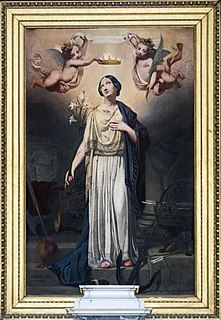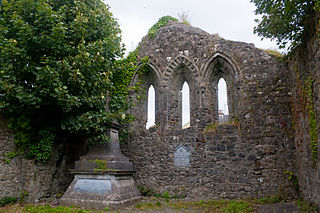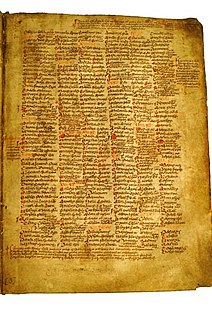
Saint Philomena was a young consecrated virgin whose remains were discovered on May 24/25 1802 in the Catacomb of Priscilla. Three tiles enclosing the tomb bore an inscription, Pax Tecum Filumena, that was taken to indicate that her name was Filumena, the English form of which is Philomena. Philomena is the patron saint of infants, babies, and youth.

Notker the Stammerer, also called Notker I, Notker the Poet or Notker of Saint Gall, was a musician, author, poet, and Benedictine monk at the Abbey of Saint Gall, now in Switzerland. He is commonly accepted to be the "Monk of Saint Gall" who wrote Gesta Karoli.
Óengus mac Óengobann, better known as Saint Óengus of Tallaght or Óengus the Culdee, was an Irish bishop, reformer and writer, who flourished in the first quarter of the 9th century and is held to be the author of the Félire Óengusso and possibly the Martyrology of Tallaght.
A martyrology is a catalogue or list of martyrs and other saints and beati arranged in the calendar order of their anniversaries or feasts. Local martyrologies record exclusively the custom of a particular Church. Local lists were enriched by names borrowed from neighbouring churches. Consolidation occurred, by the combination of several local martyrologies, with or without borrowings from literary sources.

The Martyrologium Hieronymianum or Martyrologium sancti Hieronymi is an ancient martyrology or list of Christian martyrs in calendar order, one of the most used and influential of the Middle Ages. It is the oldest surviving general or "universal" martyrology, and the precursor of all later Western martyrologies.

Saint Iarlaithe mac Loga, also known as Jarlath, was an Irish priest and scholar from Connacht, remembered as the founder of the monastic School of Tuam and of the Archdiocese of Tuam, of which he is the patron saint. No medieval Life for Iarlaithe is extant, but sources for his life and cult include genealogies, martyrologies, the Irish Lives of St Brendan of Clonfert, and a biography compiled by John Colgan in the 17th century.
Saint Fergus was a bishop who worked in Scotland as a missionary.

Ciarán of Saigir, also known as Ciarán mac Luaigne or Saint Kieran, was one of the Twelve Apostles of Ireland and is considered the first saint to have been born in Ireland, although the legend that he preceded Saint Patrick is questionable. Ciarán was bishop of Saighir (Seir-Kieran) and remains the patron saint of its successor, the diocese of Ossory.
The Roman Martyrology is the official martyrology of the Catholic Church. Its use is obligatory in matters regarding the Roman Rite liturgy, but dioceses, countries and religious institutes may add to it duly approved appendices. It provides an extensive but not exhaustive list of the saints recognized by the Church.
Saint Conan, also rarely known as Saint Mochonna, was a bishop of the Isle of Man and an Irish missionary.
Eithne and her sister Sodelb are two relatively obscure Irish saints from Leinster who are supposed to have flourished in the 5th century. They are commemorated together in the Irish martyrologies on 29 March, though 2 and 15 January were also marked out as feast-days. The 17th-century scholar John Colgan believed that a Life written for them had been witnessed in c. 1490 by Cathal Óg Mac Maghnusa, whom he regarded as the author of additions to the Félire Óengusso. Although nothing of the kind has come to light, they do make cameo appearances in the Lives of two better known 6/7th-century saints, Áedan and Moling, both bishops of Ferns.
Saint Auxilius, or Usaille, was an early Christian missionary of Ireland who is associated with Saint Patrick, Saint Seachnaill (Secundinus), and Saint Iserninus in establishing Christianity in the south of that island, although more recent studies tend to associate him with the earlier Palladius.

The Martyrology of Tallaght, which is closely related to the Félire Óengusso or Martyrology of Óengus the Culdee, is an eighth- or ninth-century martyrology, a list of saints and their feast days assembled by Máel Ruain and/or Óengus the Culdee at Tallaght Monastery, near Dublin. The Martyrology of Tallaght is in prose and contains two sections for each day of the year, one general and one for Irish saints. It also has a prologue and an epilogue.
Saint Brónach was a 6th-century holy woman from Ireland, the reputed founder and patron saint of Cell Brónche, now Kilbroney, in County Down, Northern Ireland.
Dubthach maccu Lugair, is a legendary Irish poet and lawyer who supposedly lived at the time of St Patrick's mission in Ireland and in the reign of Lóegaire mac Néill, high-king of Ireland, to which Dubthach served as Chief Poet and Brehon. In contrast to the king and his druids, he is said to have readily accepted the new religion. This event has played a major part in Hiberno-Latin and Irish sources as representing the integration of native Irish learning with the Christian faith.
Saint Carláen was the Bishop of Armagh, Ireland from 578 to 588.
Saint Fedelmid Find b. c. 500 - d. 30 October 578, was the Bishop of Armagh, Ireland from 558 to 578.
Saint Senach was the Bishop of Armagh, Ireland from 598 to 610.
Saint Ailill the First b. c.460 – d.13 January 526, was the Bishop of Armagh, Ireland from 513 to 13 January 526.
Saint Dalua of Tibradden, also called Dalua of Craoibheach, was an early Irish saint who is said to have been a disciple of St. Patrick. He founded a church that became known as Dun Tighe Bretan (Tibradden) which is located today in the townland of Cruagh, Co. Dublin.







